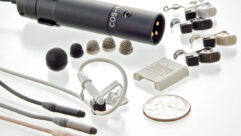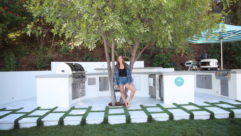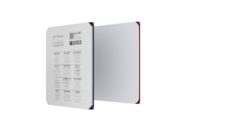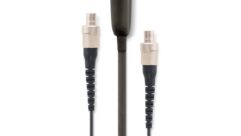Sonic concealment
Apr 1, 1999 12:00 PM,
Duke Ducoff
There is a Monty Python sketch whose hero, Dennis Moore, robs from the richto give to the poor. Dennis is so proficient that, after a while, the poorare wealthy, and the rich are destitute. When confronted with this problem,Moore delivers the punch line, “This distribution of wealth is trickierthan I thought.”
Many sound contractors reach the same conclusion when asked to provide asimple masking system for an open office complex. A contractor may say, “Norocket science needed here. Throw some 8 inch (203 mm) loudspeakers in theceiling, get a noise generator and an EQ, and have enough power for theloudspeakers. There’s a special on a 1 RU EQ. Tell the customer payment isdue in 15 days, no problem.”
The phone rings just as he gets back to the office. The customer is havingproblems with noise being so loud in some areas that people want it turnedoff. In other areas, employees can still hear one another’s conversations.This is where the fun truly begins. This scenario may be exaggerated, butit illustrates why there is a dedicated group of acoustic consultants thatdoes sound masking almost exclusively.
Did the contractor have a chance? The odds were certainly stacked againsthim when he was brought into an office complex that was already furnishedand laid out. It is important to be included in the design stage. Therewill usually be several meetings that include the HVAC designer, thearchitect, the acoustic designer and the owner, all of whom need to tacklesuch issues as what kind of lighting and sound levels are required, howclose or far away the cubicles will be to each other, how the work willmigrate through the office, what kind of background noise there will be,and what type of furniture and artwork will be used. Where cubicles areplaced and spaced relates to the overall equation.
Industry ratingsMany people in our industry have seen noise reduction coefficient (NRC)ratings as they are applied to sound panels. These have an absorptionrating for sound at 1/3-octave frequencies between 250 Hz and 2 kHz from 0to 1 (100%). Many people have been dismayed to see some products ratedhigher than 1. Higher frequencies are normally more easily absorbed thanlower frequencies. The problem with this rating is that it cannot conveyhow much sound can be stopped or how it will act as a barrier.
NRC is not to be confused with noise criterion (NC) or, as they aresometimes called, room criterion (RC) curves. These curves were developedto gauge how much sound generated by HVAC systems could be tolerated.Ratingsbelow 25 are extremely quiet; 25 to 40 is considered the norm.Anything above 40 is considered too intrusive for the office environment.For speech privacy in the open office environment, an NC rating between 35and 40 of masking noise is considered ideal. HVAC noise need not beconsidered for masking situations because it is not steady and turns itselfon and off. Music presents similar problems.
Sound transmission class (STC) has been used widely as a fully constructedassembly’s ability to reduce transmitted sound (for example, a completeceiling with tiles, HVAC returns and light fixtures or a floating floorsystem). Ratings can be anywhere from the teens to the seventies, withhigher numbers indicating better isolation. This, however, does not alwaysrelate well to an open office plan where fixtures and panels do not alwaysgo from floor to ceiling. A better method was needed.
The American Society for Testing and Materials set about coming up withstandard ratings for cubicles (based on height and position), ceilingtiles, light fixtures, furniture panels and wall fixtures. These weresubject to different ratings for speech privacy. Their committees (andsubcommittees) developed real-world results for acoustic data for openoffice plans. Now we have an articulation class (AC) rating to judge amaterial’s performance in relationship to speech privacy. The rating runsfrom a low of 100 to a high of 250; the better materials run from 180 to220. There are separate criteria for ceiling systems (how well the tileblocks reflections in the critical 45degrees to 60degrees range), acousticbarriers (how well they block out sound), and furniture panels and wallsystems (how the sound is reflected). What makes this data particularlymeaningful is that these tests are conducted in live open officesituations. Design consultants can now know what they choose.
So, just pile everything together, and it will sound great, right? It’s notthat simple. Yet another test must be carried out with a calibrated mic inone location and a calibrated loudspeaker in another (like from one cubicleto another). This is another ASTM standard, called articulation index (AI),which has a range of 0 (unintelligible) to 1 (understood). This tells youhow much of the speech can be understood. Anything below 0.35 will give youthe minimum privacy necessary.
LoudspeakersFirst, there is the completely self-contained system. The amp, loudspeaker,EQ, noise generator and enclosure are all in the same package. There aresome advantages to this system, the biggest of which is overall cost. Thesekinds of systems lend themselves to smaller installations. By having theirown noise source for loudspeakers, general incoherence is improved. Butthere are disadvantages. The EQ must be set before the unit leaves thefactory, so a change in the layout can prove troublesome. Next, 120 VACmust be run to each individual unit in a conduit. Plenum wire is usuallyacceptable for most normal, low-voltage loudspeaker lines. Paging orbackground music is no longer an option. Levels have to be set at eachunit’s location, requiring more staff. The overall quality or reliabilityof these units seems to vary greatly with units marketed by audiomanufacturers on the higher end of the scale. Units marketed by furnituremanufacturers have experienced reliability problems.
Most consultants today are leaning more toward an 8 inch (203 mm) coaxialloudspeaker (smaller sizes can work) in a fiberglass-lined enclosure, inwhich the assembly hangs in the plenum with the loudspeaker facing up. Thefiberglass absorbs the back-wave of the loudspeaker, so most of the energywill go forward. For a less expensive solution, try an empty 5 gallon (19L) paint can. You can mount ceiling loudspeakers the conventional waythrough the tile, but the sound can be reflected more easily for a moreuniform coverage without hot spots by hanging them in the plenum (seeFigure 1). The plenum should be free of obstructions, which must beaddressed in the planning stage. The loudspeakers must be placed so thatthey form a uniform pattern of coverage that extends just beyond theintended zones. Spacing of the individual loudspeakers will vary accordingto plenum depth and ceiling height. Some consultants use conventional boxloudspeakers and fire them sideways or through diffusers, depending on theplenum layout and room design. Also, planar loudspeakers that resemble theceiling tiles they replace have been used successfully in many situationsbecause of their non directional characteristics.
AmpsAmps should be designed for commercial use because the units will havealmost continuous use. Most systems use 25 V or 70 V lines, which makesconnecting loudspeakers easier. Normally, they will be tapped at 0.5 W. Ifthe loudspeakers will double for paging or background music, double ortriple output voltage. You want a minimum of a 10% cushion between theamount of total wattage the loudspeakers are tapped against the total powerof the amp. If the loudspeakers’ total voltage adds up to about 50 W, useat least a 60 W amp. This should be a hard-and-fast rule for anylow-voltage application.
The amp should be fan-cooled or have proper heat sinking and should belocated in a ventilated area. A gain control should be available from thefront of the amp or from an easily accessed volume control from the amp’sloudspeaker outputs.
Noise sourceWe start with white noise, which has equal amounts of energy at allfrequencies. When this is plotted, you get a 3 dB/octave rise. White noiseis generally used for testing electronics, never for loudspeaker response.The closest approximation you get to white noise is FM radio inter-stationnoise (when the muting is off). White noise in itself sounds a little toohissy for masking applications, so a pinking filter is applied, whichyields a 3 dB/octave roll off. Because it cancels the 3 dB/octave rise, weget noise with equal energy per octave. This gives us the nice flatfrequency response we like to see on real time analyzers, and we can bettersee what the loudspeaker is doing, or with an EQ, we can tell it what to do.
In masking, the noise source needs to be steady and stable despite voltageor temperature fluctuations. There has been some question of whether thenoise source should be digital or analog. The digital word length, whichrefers to the time elapsed before the noise repeats, must be sufficient.Analog noise sources, by nature, never repeat and are so specified inhigh-security government applications.
When a single noise source is used, there will sometimes be a barelynoticeable volume change between the loudspeaker coverage areas. This issometimes referred to as phasing. One of the growing trends in masking isusing dual noise generators for every other loudspeaker in the layout. Themost positive aspect of this trend is the reduction of the overallcoherency between the two channels and elimination of the potential phasingproblems. There is also the redundancy factor-if one channel goes down, atleast the other will still operate.
EQsThe role of the EQ is to shape the filtered noise to the consultant’sdesired curve (similar to NC-40 contour shape). Most consultants prefer1/3-octave EQs. Different EQs must be used if there is a major change inthe zone in a ceiling tile or flooring system or a radical room change, orif music or paging is to be sent through the system. When multiple EQs areused in cookie-cutter, multi-floor layouts, EQ settings must be absolutelyrepeatable. This all but eliminates slider EQs because the accuracy oftheir settings is ballpark at best. Additionally, 1 RU EQs have especiallypoor accuracy. Only the precision-knob analog EQ will give the unit-to-unitconsistency that consultants demand, but they are costly.
The digitally controlled analog EQ is the most prevalent in the markettoday. Many companies offer these with built-in noise generators. Some havefront-panel control; others work on simple PC programs. The consistency andoverall high quality of these units are desirable traits, as well as theaspect of locking out unwanted fingers.
It is of extreme importance that levels not vary more through the areas by+/-2 dB. The uniformity of the sound in all areas is paramount; yourcustomers will notice any deviations. The levels of noise are equallyimportant. Too little noise makes it is easy to hear your neighbor; toomuch noise becomes intrusive. The preferred noise level falls between NC 35and NC 40.
PricingPrice is normally figured on a per ft2 basis. Many factors affect the cost.The number of different layouts, the condition of the building structure,unique acoustical problems, workers unions, and varying layouts from floorto floor in a multi-floor layout are all potential contributing factors.
If a self-contained system is used, the pricing should fall in the 95 centsto $1.25/ft2 region. The more common centralized system will vary accordingto the number of square feet. Spaces smaller than 10,000 ft2 can be as highas $1.50/ft2. The price of these systems, however, can drop dramatically to60 cents/ft2 for environments of more than 100,000 ft2. There are chartsavailable that track this but, because of all the variables involved, thereis sometimes a reluctance to venture a set price. For a general guideline,see Figure 2.
The most important aspect of sound masking is in the planning. Convincingthe owner that everyone, especially the architect and audio consultant,needs to work closely to provide a pleasant work environment is essential.If the owner wants to try only one zone, or if he wants to see if it isnecessary after everyone moves in, his costs for an after-the-fact maskingsystem will increase exponentially. It is proven that when people are in apleasant, well-lit work environment that is free from distractions, theyare more efficient.
* AC (articulation class): numerical rating created by the ASTM to judgespeech privacy acoustical performance.
* AI (articulation index): weighted fraction between 0 and 1 that tells howmuch of the speech is intelligible.
* ASTM (American Society for Testing and Materials): conducted tests forjudging the acoustical standards for many different types of buildingmaterials. Different standards are in place for ceiling systems (StandardE111), acoustical barriers (Standard E1375) and many other materials.
* NC (noise criterion curves): curves used to relate the intrusiveness ofsuch noise as HVAC systems in buildings. NC 35 to 40 is optimum for speechprivacy. Sometimes referred to as RC (room criterion curves).
* NRC (noise reduction coefficient): rating between 0 and 1 to evaluate howmuch sound can be absorbed by a material; based on absorption coefficientsat 1/3-octave bands between 250 Hz and 2 kHz.
* RC (room criterion curves): see NC.
* STC (sound transmission class): numerical rating of a constructedassembly’s ability to reduce airborne transmitted sound, typically rangingfrom 20 to 70 with the higher number indicating better reduction.
Gregerson, John. “Setting Sounder Standards for Acoustical Performance,”Building Design & Construction, April 1992.
Herbert, R. Kring. “Office Soundscapes: Exploring Acoustic Performance,”www.facilitiesnet.com/NS/NS3b56d.html, 1996.
Joiner, David. “Acoustical Design for Open Plan Offices,” Designers West,October 1984.
Lewitz, Joel, P. E. “Electronic Sound Masking Systems,” NSCA Contractor’sConference & Expo 1993, Sales Track.
Sullivan, Edward. “A Closer Look at Elements of a Productive IndoorEnvironment,” www.facilitiesnet.com/NS/NS3bh5b.html, 1995.
Thomas, Marita. “Achieve Speech Privacy with Sound Masking Systems,”Facilities Design & Management, July, August 1984.










